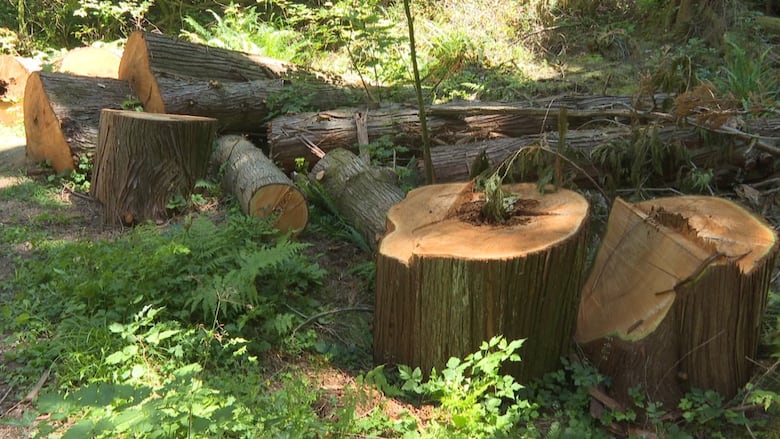Vancouver Park Board staff seeks approval to advance Stanley Park tree removal
Removal of thousands of trees due to infested hemlocks has faced criticism for years

Vancouver Park Board staff are seeking commissioners' approval to proceed with the next phase of a tree removal project in Stanley Park due to an extensive looper moth infestation.
Work has been underway to cut down thousands of trees in Vancouver's biggest park since the summer of 2023, due to what the park board said were fire and public safety risks posed by dead and dying trees that were affected by a yearslong Western hemlock looper moth infestation.
The infestation led to around a third of all the trees in Stanley Park being affected, staff said at the time, and its latest report shows just over 11,000 trees have been cut down to deal with the infestation, which was first reported in 2020.
While the tree removal plan has faced sharp criticism — and some residents filed a lawsuit that ultimately failed to stop it — staff say they have a plan that will see the least number of trees removed in the final phase of the mitigation work.
"This aims to balance key public safety risks resulting from the hemlock looper outbreak while leaving a moderate extent of internal forest areas to undergo natural forest stand regeneration," the staff motion says of its preferred approach.
"These areas may require ongoing monitoring for changes over time, including but not limited to future treatment of hazardous trees and/or replanting."

Staff said that the final phase of tree removal work would focus on around 42 per cent of the park's area, totalling around 111 hectares primarily within the park's interior.
Those areas include trees around the Lees Trail, Lovers Walk, Tatlow Walk and trails surrounding Beaver Lake.

"From a public safety perspective, these trails are considered the primary target to mitigate risk from declining trees for this final phase," the staff report reads.
Park board commissioners will debate the report and the final phase of the tree mitigation work at a meeting Monday evening.
Work along seawall complete
The motion says that higher-traffic areas — like the seawall and Stanley Park Drive — have already seen mitigation work conducted since 2023 in a phased approach.
For the last phase of work, staff said that it prefers an option that would see a 40-metre buffer zone around trails, where problem trees would be removed and mitigation work conducted.
According to park board staff, that would have the lowest costs compared to two other options available, which would have increased the size of the buffer zone and could have increased the amount of trees being cut down.
Just under $18 million has been spent on the tree removal and looper moth mitigation work since 2023.
Staff did not provide an exact budget figure for the last phase of work, though they estimated the contract figure would exceed $3 million in value.
If commissioners approve of the staff plan, planning for tree removal and mitigation work would begin later this year and conclude in the first quarter of 2027.


